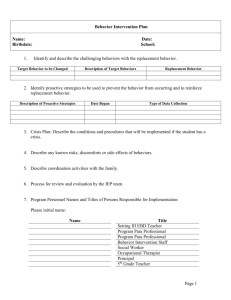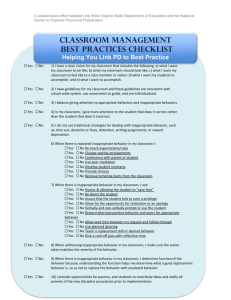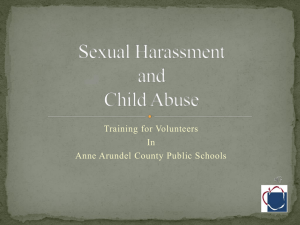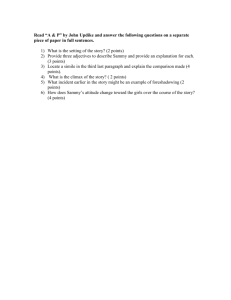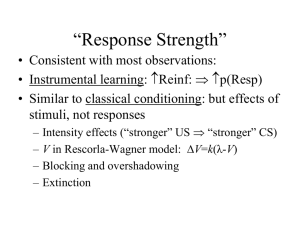Assessment & Intervention Strategies for Behavior
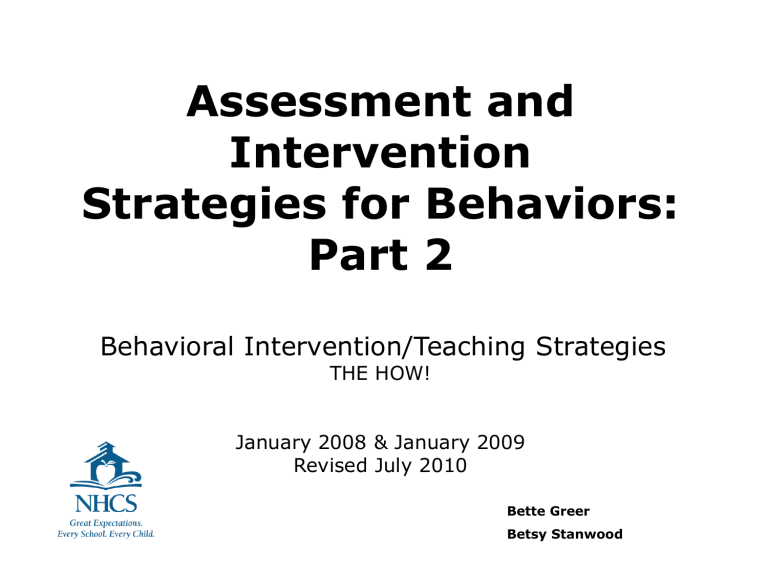
Assessment and
Intervention
Strategies for Behaviors:
Part 2
Behavioral Intervention/Teaching Strategies
THE HOW!
January 2008 & January 2009
Revised July 2010
Bette Greer
Betsy Stanwood
Functions of Behavior
Pos Reinf
Target
Behavior
Neg Reinf
Attention
From:
Peers
Staff
Preferred
Adult
Power
For:
Control
Intimidation
Vengeance
Escape/
Avoidance
Of:
Person
Activity
Classroom
Self
Stimulation
To reduce:
Anxiety
Fear
Functions of Behavior
Pos Reinf
Target
Behavior
Neg Reinf
Attention
From:
Peers
Staff
Preferred
Adult
Hypothesis Statement for John
Sample from FBA:
When John is in a whole group instructional classroom setting and is not recognized by the adult he typically responds by talking out to gain attention
What is the Observed Target Behavior from FBA:
Talking out
Function of John Sample’s Behavior from FBA:
Attention
Now define the Target ( Inappropriate ) behavior for John in observable terms!
Describe John’s Target
(Inappropriate) Behavior
What Does It
Look Like?
•Frantic hand waving
•Pouting when not called on by teacher or staff
•Rolling around on the carpet after being reprimanded
•Wandering from assigned area
What Does It
Sound Like?
•Calling out without teacher recognition
•Talking to neighbor
•Making negative comments following another student’s response
•Making noises that all can hear during lesson
Describe Possible Replacement Behaviors for John Sample
What Do Appropriate Replacement Behaviors Look Like?
•Raising hand without waving arm
•Waiting without pouting for teacher recognition
•Responding by correcting behavior after being reprimanded
•Remaining in assigned area
•Waiting without calling out for teacher attention
•Listening without talking to neighbor
•Listening to another student’s response without commenting
•Listening without making noises that all can hear during lesson
What Replacement Behavior Do We
Need to Teach John?
How to gain “Attention” appropriately
Teaching Strategies:
1.
Talk Ticket http://www.interventioncentral.com/htmdocs/interventions/behavior/talkticket.php
2.
Breaking the Attention-Seeking Habit: The Power of Random
Positive Teacher Attention http://www.interventioncentral.com/htmdocs/interventions/behavior/ncrft.php
3 . Verbal Outbursts http://dpi.wi.gov/sped/doc/ebdveroutb.doc
4.
Student Help Signal http://www.interventioncentral.com/htmdocs/interventions/study/helpsignal.php
5.
Rubber Band Intervention http://www.interventioncentral.com/htmdocs/interventions/behavior/ rubberband .php
Teaching Strategies Continued
1. Photos of student presenting target behavior and replacement behavior
VISUAL
CUES
1. Visual cue card to prompt student to use replacement behavior
Stop
Finish work Tyler
Use your calm space draw read
Wait a minute
Quiet Tyler
Good Work Tyler
Functions of Behavior
Pos Reinf
Target
Behavior
Neg Reinf
Power
For:
Control
Intimidation
Vengeance
Hypothesis Statement for Sally
Solution from FBA:
When Sally is in a classroom setting and is asked to complete a task she typically responds by refusing to engage to gain power and control.
What is the Observed Target Behavior from FBA:
Refusal to Engage in Tasks
Function of Sally Solution’s Behavior from FBA:
Power
Now define the Target (Inappropriate) behavior for Sally in observable terms!
Sally Solution Activity
Step 1:
In Teams, define Sally’s Inappropriate
Behavior
Step 2:
In Teams, define Sally’s Target/Desired
Replacement behaviors that will taught.
Describe Sally’s Target
(Inappropriate) Behavior
What Does It
Look Like?
•Head down
•Pushing away materials
•Ripping worksheets
•Breaking pencils
What Does It Sound
Like?
•Saying “NO!”
•Saying threatening things like
“I’m going to hit you!”, “You can’t make me do this!”, etc.
•Screaming
•Slamming materials to the floor
Describe Possible Replacement Behaviors for Sally Solution
What Do Appropriate Replacement Behaviors Look Like?
•Head up & looking at teacher
•Using materials correctly (i.e. without ripping, or throwing, without breaking pencils)
•Requesting assistance instead of saying “no”, threatening or screaming.
•Requesting use of an alternate or modified task
What Replacement Behavior Do We
Need to Teach Sally?
How to gain “power/control” appropriately
Teaching Strategies
1.
Passive Resistance http://dpi.wi.gov/sped/doc/ebdnoncomp.doc
2.
School-Wide Strategies for Managing... DEFIANCE / NON-
COMPLIANCE http://www.jimwrightonline.com/php/interventionista/interventionista_intv_list.php?prob
_type=defiancenon_compliance
– Allow the Student a 'Cool-Down' Break
– Ask Open-Ended Questions
– Do Not Get Entangled in Arguments
– Emphasize the Positive in Teacher Requests
– Increase 'Reinforcement' Quality of the Classroom
– Keep Responses Calm, Brief, and Businesslike
– Offer the Student a Face-Saving Out
– Listen Actively
Functions of Behavior
Pos Reinf
Target
Behavior
Neg Reinf
Escape/
Avoidance
Of:
Person
Activity
Classroom
Hypothesis Statement for Fred
Refusal from FBA:
When Fred is in the regular classroom setting and is asked to complete an assignment he typically responds by tearing or destroying materials to gain escape/avoidance.
What is the Observed Target Behavior from FBA:
Tearing or destroying materials
Function of Fred Refusal’s Behavior from FBA:
Escape/Avoidance
Now define the Target (Inappropriate) behavior for Fred in observable terms!
Fred Refusal’s Activity
Step 1:
In Teams, define Fred’s
Inappropriate Behavior
Step 2:
In Teams, define Fred’s
Target/Desired Replacement behaviors that will taught.
Describe Fred’s Target
(Inappropriate) Behavior
What Does It Look
Like?
•Tearing up worksheets
•Marking/scribbling on paper
•Breaking pencils
What Does It Sound
Like?
•Making inappropriate comments to other students
•Slamming books on the floor
•Knocking over desks
Describe Possible Replacement Behaviors for Fred Refusal
What Do Appropriate Replacement Behaviors Look Like?
•Raising hand without waving arm
•Asking teacher for help with difficult work either verbally or with the use of a visual
•Asking for a calm break either verbally or with the use of a visual
•Asking teacher to show him an example verbally or with the use of a visual
•Tearing up non-school related paper as a release
•Asking teacher for alternate work using a script card
•Utilizing a wait card and “I’m Waiting” folder
What Replacement Behavior Do We
Need to Teach Fred?
How to gain “Escape/Avoidance” appropriately
Teaching Strategies:
1.
Accommodating All Students: 'Classic' Ideas That Teachers
Can Use to Diversify Classroom Instruction http://www.interventioncentral.org/htmdocs/interventions/genAcademic/classic.php
• Write assignments or complex directions on the board in addition to saying them Create easy-to-follow 'strategy' sheet that lays out academic problem-solving steps in a clear manner for student to refer to as needed. Give copies of this model to each student, and mount poster-size versions on classroom walls.
• Teach students acceptable, unobtrusive ways to get academic assistance from peers.
• Put together 'help-signal' program: when a student gets 'stuck' on seatwork, he or she displays help-signal (e.g., brightly colored index card) on desk, switches to other work until teacher is freed up to approach and provide assistance.
• Train classmates (or even older students from another classroom) to serve as floating 'peertutors' during seatwork, circulating around classroom to help students in difficulty.
• Keep instructions brief. Break multi-step directions into smaller subsets-and have the student complete one subset before advancing to another. Use simple, clear language.
2.
Reducing Problem Behaviors Through Good Academic
Management: 10 Strategies http://www.interventioncentral.org/htmdocs/interventions/behavior/edtchng.php
Functions of Behavior
Pos Reinf
Target
Behavior
Neg Reinf
Self
Stimulation
To reduce:
Anxiety
Fear
Hypothesis Statement for
Sammy Stem Refusal from FBA:
When Sammy is in an instructional classroom setting and is asked to participate or listen to the group discussion he typically responds by scripting out loud a cartoon episode to gain self-stimulation.
“I'm happier 'n a tornado in a trailer park!
“
What is the Observed Target Behavior from FBA:
Scripting
Function of Sammy Stem’s Behavior from FBA:
Self Stimulation
Now define the Target (Inappropriate) behavior for Sammy in observable terms!
Sammy Stem’s Activity
Step 1:
In Teams, define Sammy’s
Inappropriate Behavior
Step 2:
In Teams, define Sammy’s
Target/Desired Replacement behaviors that will taught.
“I'm happier 'n a tornado in a trailer park!
“
Describe
Sammy’s Target
(Inappropriate) Behavior
What Does It Look
Like?
•Staring ahead and smiling
•Rocking back and forth
•Lips moving
•Hands in motion
What Does It Sound
Like?
•Making noises such as car sounds
•Verbalizing words with character intonations
•Making loud responses
Describe Possible Replacement Behaviors for Sammy Stem
What Do Appropriate Replacement Behaviors Look Like?
•Raising hand to request a sensory break
•Moving to the back of the room to the “calm space” area to listen to a tape or engage in a prescribed activity
•Presenting a cue card requesting removal from the class
•Drawing perseverative thoughts rather than speaking them
What Replacement Behavior Do We Need to Teach Sammy?
How to gain “self stimulation” appropriately
Teaching Strategies:
1. Redirect self stim behavior
• Use the directive, "no movie talk"
• Used both auditory and written cues to redirect scripting by stating, "we are not talking about the “The Godfather” right now, we are talking about school“
• If the stim is "movie talk" and is some how relative to school I may follow the child's lead and say,
"Oh, you watched “The Godfather” last night?“
“I made him an offer he couldn’t refuse!”
Teaching Strategies Continued
2.
Present a Social Story on why scripting bothers others
3.
Teach student appropriate way to seek help
4.
Increase use of language
5.
Define a process to take a break
6.
Create a method to allow student to define needs
7.
Use a diet of sensory input.
8.
Determine the reason for the stim
– define what the student should be doing instead of stimming
Other Examples of
Teaching Strategies
Pos Reinf
Target
Behavior
Neg Reinf
“Reduce Frustration When Coming in Late”
1. Role play what student needs to do when coming in late
2. Utilize student/teacher agreement for minimizing frustration
• Sharpen pencil at the end of the day in preparation for the next day
• Keep lunch ticket in designated place so he can fill it out quietly when coming in late
• Say to teacher, “I missed that part, can you explain it to me?” when having missed the initial instruction
3. Teach the use of calming strategies
• Identify behaviors related to escalating frustration
• Utilize appropriate de-escalating tools or strategies
“Interact with Peers Appropriately”
1.
Role play acceptable and unacceptable ways to attain peer attention
2.
Utilize a preferred peer to give visual feedback
(thumbs up/thumbs down) to indicate student’s use of acceptable or unacceptable attention seeking behavior
3.
Participate in structured game play with peers
4.
Pre-teaching of role when participating in cooperative learning groups in the general ed classroom
“Interact with Peers Appropriately”
Continued
3. Engage in problem solving discussion using a Problem
Solving Worksheet
“Communicate Need for
Academic Assistance”
1.
Role play how to ask for help before getting upset
2.
Use visual strategies and tools to request assistance
3.
Create a “Secret Signal” with teacher to request help
4.
Utilize a “Questions for Teacher” folder to be used at a scheduled time to talk to teacher for clarification
HELP
?
Resources
-
-
-
NHCS Positive Behavioral Interventions and Supports Training Modules
NHCS Student Support & Intervention
System Manual
Why Johnny Doesn’t Behave by Barbara
Bateman & Annemieke Golly
Web Resources http://dpi.wi.gov/sped/ebdbluepri.html
http://www.interventioncentral.com/ http://www.pbis.org/main.htm
